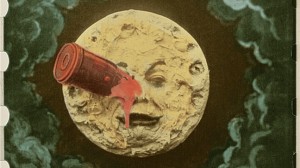 The comparison is never particularly useful because the times are so different, but amidst all the hubbub surrounding 3D films, it’s important to at least remember that every progression in filmmaking technology endured a painful struggle. Color perhaps had the nastiest of all, as the transition (which was sought from the very beginning of motion pictures) was filled with aborted technologies that used all sorts of bizarre, typically terrible methods to achieve color movies. Before Technicolor got in the game and finally figured out how to expose for color and duplicate it on single layer film, the most pleasing method was actually the most low-tech: hand painted frames!
The comparison is never particularly useful because the times are so different, but amidst all the hubbub surrounding 3D films, it’s important to at least remember that every progression in filmmaking technology endured a painful struggle. Color perhaps had the nastiest of all, as the transition (which was sought from the very beginning of motion pictures) was filled with aborted technologies that used all sorts of bizarre, typically terrible methods to achieve color movies. Before Technicolor got in the game and finally figured out how to expose for color and duplicate it on single layer film, the most pleasing method was actually the most low-tech: hand painted frames!
While most wouldn’t know it, the frame-by-frame tinting method was actually applied to one very special film- Georges Melies’ A Trip To The Moon. Finished a mere two years after the turn of the century, it was one of the early, great motion picture achievements. Using his knowledge of theatrical trickery and some invented methods of his own, Melies filled his early science fiction film (an adaptation of Verne) with spellbinding imagery that is still charming to watch over a century later. We’re used to viewing the film in grainy black and white, but a hand-tinted print was discovered in the early 90s, and almost 20 years later (after a significant financial investment) a fully restored print was finished and attached to Woody Allan’s Midnight in Paris film to open the Cannes film festival. There are more festival appearances coming.
The publishers decided to go with the trendy new score route for this restoration, and commissioned AIR to compose a new batch of music for the piece. While this might make some cineastes wince, it’s a fact that many old silent films like this had very unofficial scores, or were simply accompanied by an improvising pianist, so the scores of few films are particularly sacrosanct.
I do hope to catch a screening of this restoration in a theater- it sounds like they’ve done a good job capturing the texture and warmth of the print, and I’m curious about that new score. It’s always a fine thing when they recover the early history of the artform.
DISCUSS THIS on the CHUD Message Board
&
Like / Share it on Facebook (above or below) if you think it’s great!
Source | THR